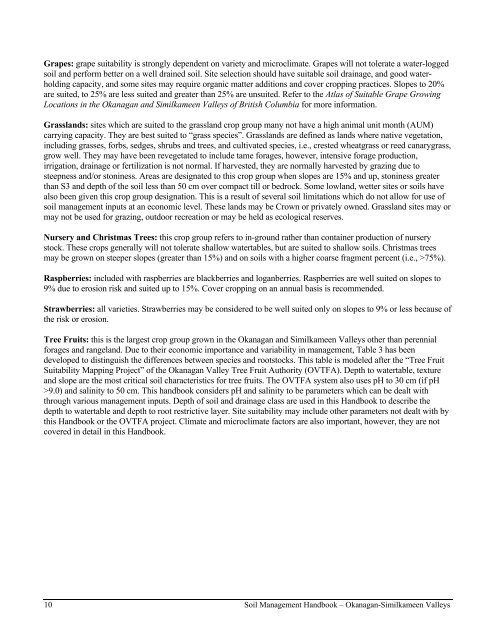Soil Management Handbook - Ministry of Agriculture and Lands
Soil Management Handbook - Ministry of Agriculture and Lands
Soil Management Handbook - Ministry of Agriculture and Lands
You also want an ePaper? Increase the reach of your titles
YUMPU automatically turns print PDFs into web optimized ePapers that Google loves.
Grapes: grape suitability is strongly dependent on variety <strong>and</strong> microclimate. Grapes will not tolerate a water-logged<br />
soil <strong>and</strong> perform better on a well drained soil. Site selection should have suitable soil drainage, <strong>and</strong> good waterholding<br />
capacity, <strong>and</strong> some sites may require organic matter additions <strong>and</strong> cover cropping practices. Slopes to 20%<br />
are suited, to 25% are less suited <strong>and</strong> greater than 25% are unsuited. Refer to the Atlas <strong>of</strong> Suitable Grape Growing<br />
Locations in the Okanagan <strong>and</strong> Similkameen Valleys <strong>of</strong> British Columbia for more information.<br />
Grassl<strong>and</strong>s: sites which are suited to the grassl<strong>and</strong> crop group many not have a high animal unit month (AUM)<br />
carrying capacity. They are best suited to “grass species”. Grassl<strong>and</strong>s are defined as l<strong>and</strong>s where native vegetation,<br />
including grasses, forbs, sedges, shrubs <strong>and</strong> trees, <strong>and</strong> cultivated species, i.e., crested wheatgrass or reed canarygrass,<br />
grow well. They may have been revegetated to include tame forages, however, intensive forage production,<br />
irrigation, drainage or fertilization is not normal. If harvested, they are normally harvested by grazing due to<br />
steepness <strong>and</strong>/or stoniness. Areas are designated to this crop group when slopes are 15% <strong>and</strong> up, stoniness greater<br />
than S3 <strong>and</strong> depth <strong>of</strong> the soil less than 50 cm over compact till or bedrock. Some lowl<strong>and</strong>, wetter sites or soils have<br />
also been given this crop group designation. This is a result <strong>of</strong> several soil limitations which do not allow for use <strong>of</strong><br />
soil management inputs at an economic level. These l<strong>and</strong>s may be Crown or privately owned. Grassl<strong>and</strong> sites may or<br />
may not be used for grazing, outdoor recreation or may be held as ecological reserves.<br />
Nursery <strong>and</strong> Christmas Trees: this crop group refers to in-ground rather than container production <strong>of</strong> nursery<br />
stock. These crops generally will not tolerate shallow watertables, but are suited to shallow soils. Christmas trees<br />
may be grown on steeper slopes (greater than 15%) <strong>and</strong> on soils with a higher coarse fragment percent (i.e., >75%).<br />
Raspberries: included with raspberries are blackberries <strong>and</strong> loganberries. Raspberries are well suited on slopes to<br />
9% due to erosion risk <strong>and</strong> suited up to 15%. Cover cropping on an annual basis is recommended.<br />
Strawberries: all varieties. Strawberries may be considered to be well suited only on slopes to 9% or less because <strong>of</strong><br />
the risk or erosion.<br />
Tree Fruits: this is the largest crop group grown in the Okanagan <strong>and</strong> Similkameen Valleys other than perennial<br />
forages <strong>and</strong> rangel<strong>and</strong>. Due to their economic importance <strong>and</strong> variability in management, Table 3 has been<br />
developed to distinguish the differences between species <strong>and</strong> rootstocks. This table is modeled after the “Tree Fruit<br />
Suitability Mapping Project” <strong>of</strong> the Okanagan Valley Tree Fruit Authority (OVTFA). Depth to watertable, texture<br />
<strong>and</strong> slope are the most critical soil characteristics for tree fruits. The OVTFA system also uses pH to 30 cm (if pH<br />
>9.0) <strong>and</strong> salinity to 50 cm. This h<strong>and</strong>book considers pH <strong>and</strong> salinity to be parameters which can be dealt with<br />
through various management inputs. Depth <strong>of</strong> soil <strong>and</strong> drainage class are used in this <strong>H<strong>and</strong>book</strong> to describe the<br />
depth to watertable <strong>and</strong> depth to root restrictive layer. Site suitability may include other parameters not dealt with by<br />
this <strong>H<strong>and</strong>book</strong> or the OVTFA project. Climate <strong>and</strong> microclimate factors are also important, however, they are not<br />
covered in detail in this <strong>H<strong>and</strong>book</strong>.<br />
10 <strong>Soil</strong> <strong>Management</strong> <strong>H<strong>and</strong>book</strong> – Okanagan-Similkameen Valleys
















